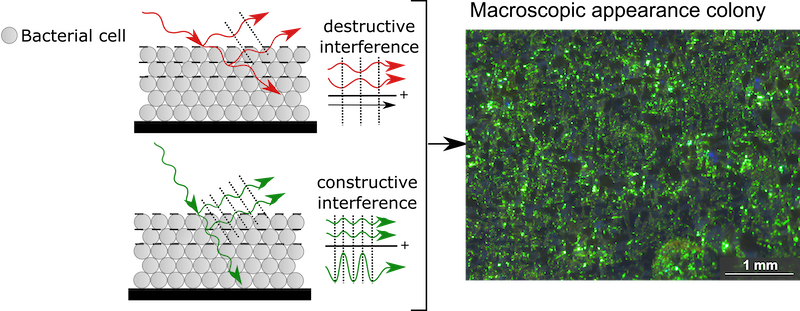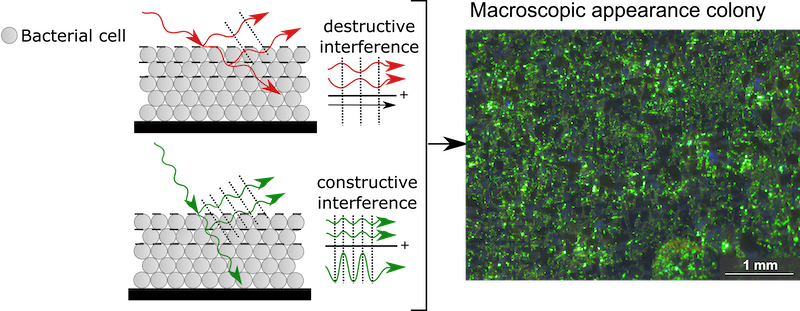
Gea van de Kerkhof
Structurally coloured bacterial colonies
Keywords: structural colour, bacteria, biophotonics, biophysics, biochemistry
We observe objects to be coloured when light waves with a specific wavelength are being reflected off that object (where wavelength equals the distance between the peaks of the wave). Because of the relation between the wavelength and the colour we see, an object that reflects a light wave of different wavelength will have a different colour.
Perhaps the most commonly known method to make such coloured light waves is through pigmentation. In pigmented colour, white light that contains waves of all different wavelengths falls onto an object, but most of the wavelengths will be absorbed by the pigment. Only the light waves that are not absorbed will be reflected, and they will be responsible for the colour you see.
However, not all colours are created this way. Some of the most brilliant colours in nature are made through the interaction of light with tiny structures. This mechanism is called structural colouration. Here, light waves that travel through the object are reflected off different parts of the structure. When the light waves then leave the structure, some will have their peaks aligned with each other, creating an increased intensity (to use the technical term: constructive interference). Others will be misaligned, resulting in a reduced intensity (destructive interference). As a result, only certain wavelengths, certain colours, will be visible.
Structural colour is widespread in nature, and it is the mechanism that for example gives colour to a peacock’s beautiful tail feathers, or to the shiny scales of the green dock beetle. Moreover, structural colour also appears in micro-organisms, such as bacteria. Bacteria grow together in groups, called colonies. Structurally coloured bacteria have the unique ability that they can organise themselves to form ordered structures, which interact with light in a way that gives the colony as a whole an iridescent colour. In this study, we have researched such structurally coloured bacterial systems.
We first investigated the relation between the organisation of the bacterial cells and the visual appearance of the system. We then applied this knowledge to use the visual appearance as a tool for discovering the bacterial organisation with a resolution as high as 10 nm (0.000 000 01 meter). As a result, we have developed an in-depth understanding of how the way the cells are ordered affects the visual appearance of these systems, for example how the colour of a colony that is a little less ordered than others will change from iridescent to matte.
We then continued to explore how the uptake of certain nutrients by the bacteria can affect this organisation, revealing a so-called “metabolic pathway” that is involved in the colouration. We have found that, depending on the food source available, these bacteria can change their colour from iridescent green to matte purple.
Lastly, we studied how different types of bacteria, which use different mechanisms to move around, can create structural colours with a different appearance. We now have a good understanding in the difference in ordering and visual appearance of these various types, with some interesting questions left as to what role their mechanisms of moving play in these variations.
Studying these bacterial colours is interesting in itself, since it is a unique system and there is not much known about why the bacteria create these colours, but also from the perspective of creating new colourful materials. Some of these bacteria that are harmless, and will not make you sick, could be used to make sustainable biomaterials. Examples could be biological colourants, but also biological sensors, where the bacteria change colour depending on their food source.
Department of Chemistry
Vignolini Lab @VignoliniLab
Figure legend: Interference mechanism creating colour in structurally coloured bacterial colonies. On the left, the mechanism of how light interference can create colour in highly ordered bacterial colonies is shown. In this example, red light waves that leave the structure have their peaks in one wave aligned with valleys in another. This results in a decrease of the intensity of the red light (destructive interference). In contrast, green light has its peaks lined up with other peaks, enhancing the signal (constructive interference). The combined mechanism results in the glittery green colour you can see in the image of a bacterial colony on the right.


